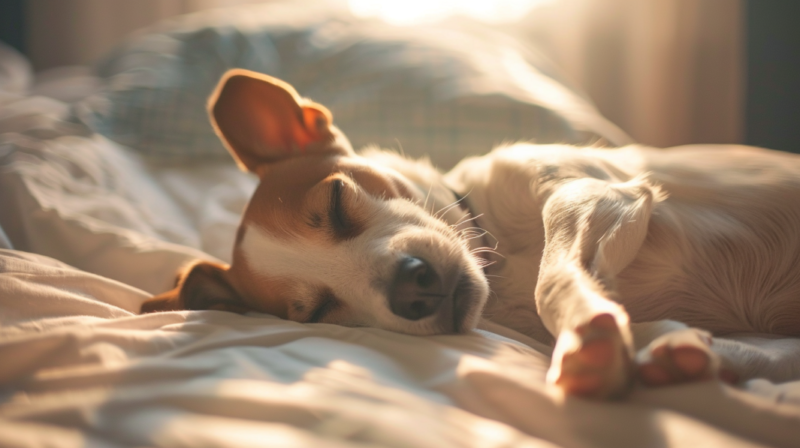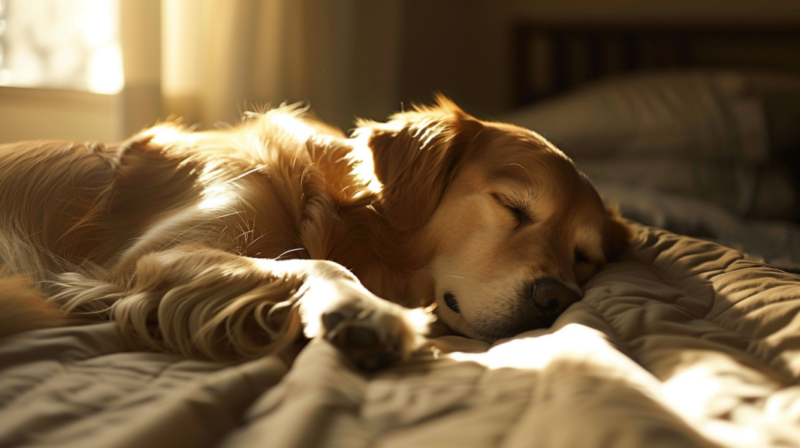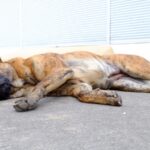Our furry companions often show signs of dreaming, displaying little twitches, soft barks, or rapid eye movements while they sleep. So, do they actually dream? Science says – absolutely!
Have you ever seen your furry buddy kick or whine during sleep, just like they’re running or chasing something in their dreams? Observing these episodes in your dog can be heartwarmingly funny and sometimes a little odd, raising the question: Do dogs experience dreams in the same way we do?
Interestingly, the structures of the human brain and a dog’s brain are quite similar. According to a study by Matthew Wilson and Kenway Louie of MIT in 2001, the patterns of brain waves during sleep are strikingly similar in humans and dogs[1]. This indicates that both species go through similar stages of electrical activity in their brains, implying that dogs do, in fact, dream – much like we do.
Yet, the mystery remains – what do our canine pals dream about? Our journey of understanding the dream world of dogs continues. We’re looking forward to getting access to the actual MIT study, which, despite being cited in numerous articles, is currently not available online. We promise to update you with more insights once we’re able to dive deeper into the research.
What Do Dogs Dream About?

Before we can answer this question, it’s important to look into the science of dogs’ sleeping patterns.
Most of the dreams that humans have at night are associated in one way or another with the activities that they partake in during the day. Those can be either physical or mental activities.
According to Psychology Today quoting the very same scientific paper we’ve discussed above, researchers at MIT have conducted some in-depth study of the brain activity of dogs while they sleep.
One study showed that when the pons, or the structure in the brain-stem that keeps people and animals from acting out their dreams, were removed or inactivated in dogs, they began to move around, despite the fact that their brain recordings showed they were still asleep. Dogs only begin to move during the REM stage of sleep that is associated with dreaming.
Let’s take a closer look at the stages of sleeping as a process itself and how exactly do dogs start dreaming.
SWS and REM Sleeping Types
Just like humans, dogs have two different types or stages of sleep. When a dog first falls asleep, they enter the slow wave sleep (SWS) in which the mental processes are quiet but the muscle tone is the same. The other stage of sleep is called rapid eye movement (REM) and in this stage the body becomes fully relaxed but the mind is working rapidly and the eyes dart quickly.
During the SWS stage, the brain waves become slow and undulating. At this point, your dog will look like he/she is just calmly resting. Pets are much easier to awake in this stage and their muscles are not completely relaxed yet.
On the contrary, while in REM sleeping stage, the brain waves are fast and irregular, similar to when the dog is awake. Heightened mental activity is apparent during REM sleep which is why they may move their legs like they are running. You will also hear your dog whine, whimper, breathe quickly or even hold their breathe. All of this is totally normal when your dog is in REM sleep.
Some owners occasionally express their concern over this – especially when the dog is being very active and loud quite often – but you should know that this is absolutely natural and there’s nothing to worry about.
In terms of the switch between SWS and REM, most experienced dog owners know that you don’t really need to resort to brain surgery and you don’t have to hook your dog up to electrical recordings in order to figure out when they are dreaming. If you observe your pooch sleeping, you will be able to easily tell when they transition from SWS to REM sleep.
As their sleep becomes deeper and they move closer to REM sleep mode, their breathing will become deeper and more regular (same as humans). Generally, an average-sized dog will achieve REM sleep after about 20 minutes of uninterrupted sleep.
You may notice their breathing becoming irregular and some random muscle twitches. If you look closer at their eyes, you will begin to notice them twitching under their eyelids.
The Length of Dreams Depends on Your Dog’s Breed and Size

According to psychologist Stanley Coren, studies on the sleep cycles of dogs have also proven that the length and frequency of dreams is directly related to the animal’s size.
Large breeds may only dream every 45 to 60 minutes with dreams lasting 5-10 minutes. However, small breeds may dream as often as every ten minutes but their dreams may only last a minute or so. It was also found that puppies and older dogs dream more often than middle-aged dogs.
The amount of sleep that a dog requires is also contingent to its size. Larger breeds need more sleep and smaller breeds may be awake most of the day.
The amount of rest a dog requires and the sleep cycle he or she has also depends upon the amount of activity they get during the day. Because dogs wake far more frequently than we do, sometimes it is hard to catch them in REM sleep.
Normally, REM type of sleep happens when a dog is more tired, and a dark night after some strenuous exercise is the perfect time for that. As you can tell, humans have a lot in common with dogs.
Don’t Wake a Sleeping Dog Unless Necessary

Because dogs do indeed dream, it is important to remember to leave them alone while they are taking they sleep. Aside from the fact that it’s only fair to let them get their rest, there are also dangers involved with waking up a dog from either type of sleep.
Nearly 60 percent of children who are bitten by dogs are bitten when they wake a sleeping dog. This has nothing to do with Post-traumatic Stress Disorders, poor behavior problems or anything similar. This is a legitimate and healthy reaction, and some humans can react this way as well.
It’s important to understand that there is no way of knowing for a fact what your dog is dreaming about at that particular moment. If they are dreaming of attacking a burglar, chasing the neighbors cat, or something as simple as chewing a bone, they may not distinguish between the dream and reality if woken suddenly.
We’ve all had dreams that felt so real it took us a minute to get our bearings when we awoke, and the same can happen with dogs. Make sure to teach children to never bother a dog while he/she is sleeping.
As the old saying goes, “it is best to let sleeping dogs lie.” But whenever you do have to bother your pets and wake them up, try to avoid touching them and rather wake them up with a soft voice. It’s as simple as that.
So What Do Dogs Dream About Anyway?
We finally reached the most interesting question of what do dogs dream about when they sleep.
Because the links are so strong between the types of sleep and sleep cycles in humans and dogs, researchers are positive that what dogs dream about is also similar.
Human brains act equivalently in REM sleep to the way they act while awake, and the same is true for dogs. Therefore, it is safe to say that your dog is probably dreaming about the things that he or she likes to do when they are awake. Pointers may dream of flushing birds out of bushes and Labradors may dream they are swimming to retrieve a duck.
Since dogs cannot tell us what dream they had last night, it is still impossible to know if they have good dreams or bad dreams. However, because they dream in much the same way as we do, they probably do have bad dreams as well as good ones. Whether they have actual nightmares that make them sweat is hard to say.
Interestingly, some people argue that dogs that have been traumatized by abuse dream much less than dogs that haven’t. This could be due to them not falling into REM sleeping mode as often, since they might be trying to stay alert at all times, but there’s still no proof to that.
Fact or Fiction?

Some people do not believe that such similarities mentioned above between dogs and people even exist, but science has proven them wrong (and we’ll be publishing the actual studies as soon as we get a hold of them). As you can see from the information above, we are more alike than many people realize.
So the next time you notice your dogs yipping and twitching away in their sleep, just enjoy the entertainment peacefully and know that they are probably trying to finally catch that neighbor’s cat.
Final Words
In conclusion, science suggests that dogs do indeed dream, likely replaying their daily activities in their sleep. Their dream patterns and frequency can vary based on the breed’s size and age, with puppies and older dogs dreaming more frequently.
However, as dogs cannot share their dream experiences, this is mostly speculative based on observable behaviors and similarities to human sleep patterns. It’s essential to let sleeping dogs lie to prevent unexpected reactions.
So next time you see your canine friend twitching or making noises in their sleep, they might be reliving their day, possibly chasing after that elusive squirrel from the park.







